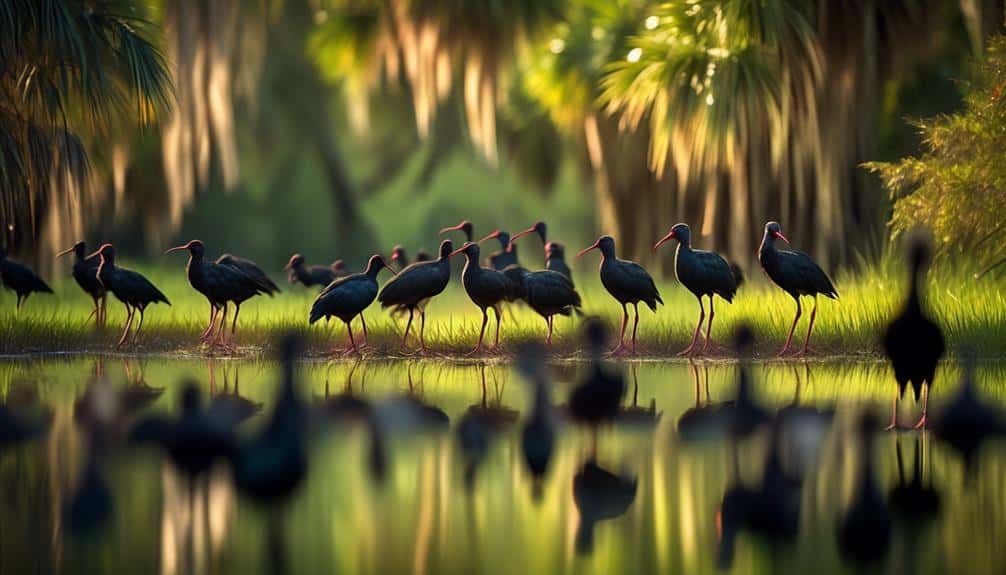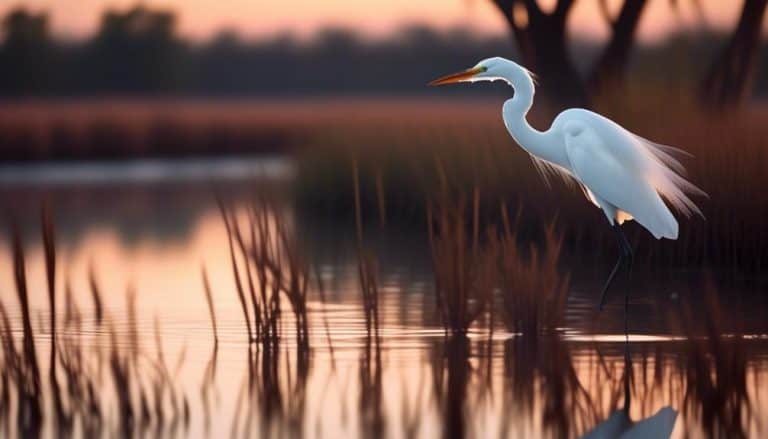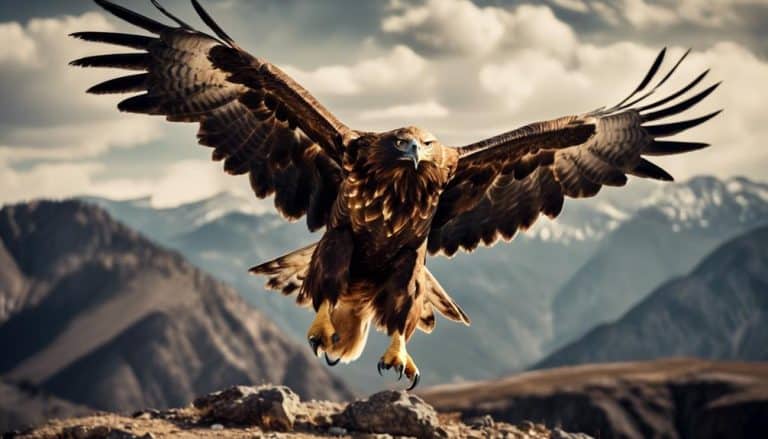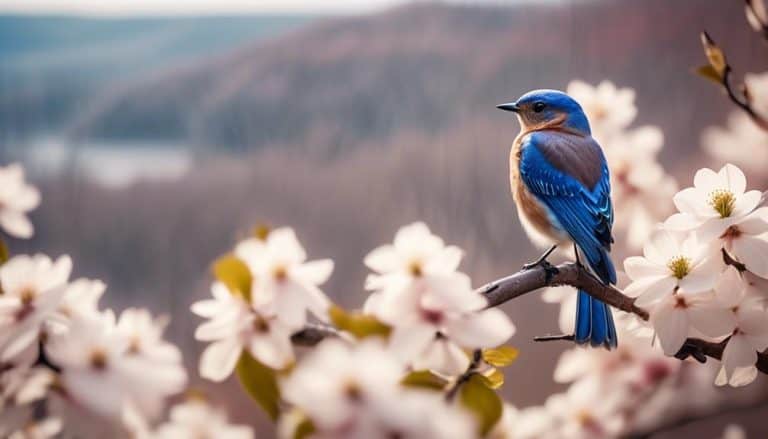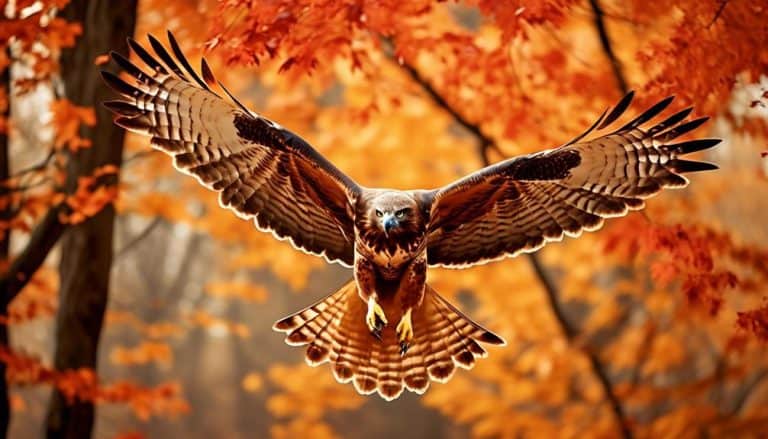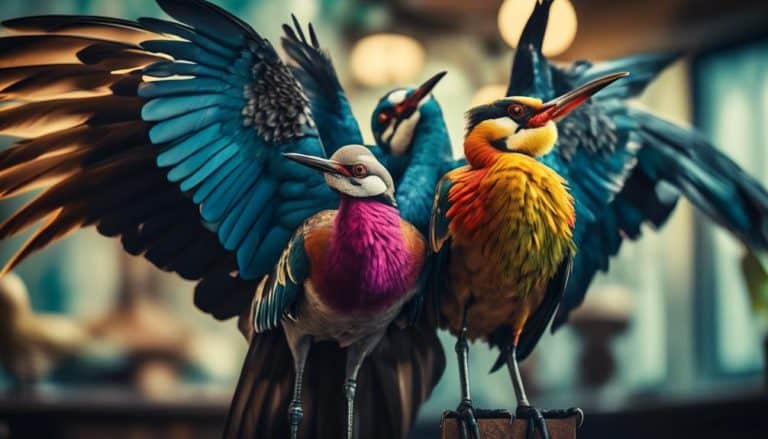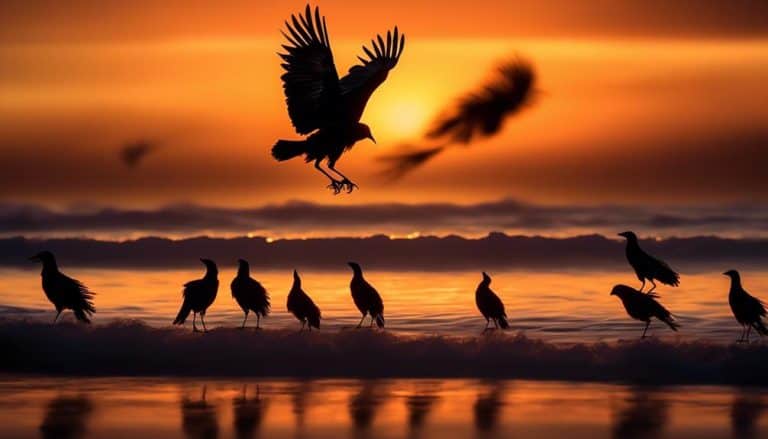As I sit here, sipping my coffee on this warm Florida morning, I can't help but marvel at the diverse array of wildlife that graces this state. Among the countless species that call Florida home, there is one group of birds that has always captured my attention – the Florida Black Birds.
These enigmatic creatures have long fascinated both birdwatchers and researchers alike, with their mysterious behaviors and striking appearance. From their habitats to their role in the delicate ecosystem, there is much to uncover about these captivating birds.
But before we delve into the depths of their world, let me share with you a glimpse of their fascinating existence.
Common Species of Florida Black Birds
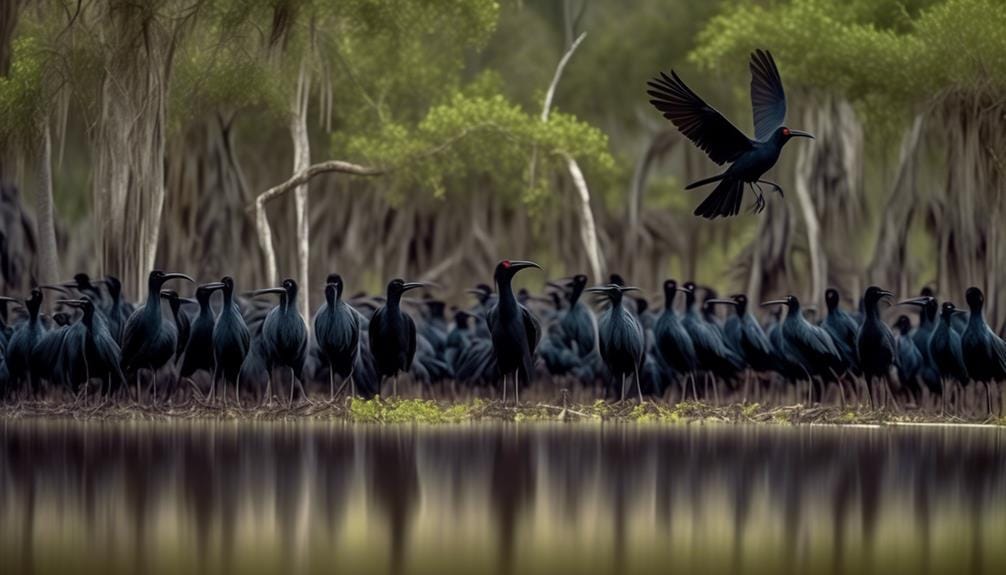
As I gaze upon the diverse avian inhabitants of Florida, I'm captivated by the common species of black birds that grace the skies with their elegant presence. Florida is home to several species of black birds, including the Red-winged Blackbird (Agelaius phoeniceus), Common Grackle (Quiscalus quiscula), and Boat-tailed Grackle (Quiscalus major). These black birds are an integral part of the Florida black bird populations and exhibit fascinating migration patterns and habits.
The Red-winged Blackbird is a familiar sight in Florida, with its striking red shoulder patches and distinctive call. They're known for their highly social behavior and often gather in large flocks. During migration, they form massive groups that can number in the thousands, creating a mesmerizing spectacle in the skies.
The Common Grackle, with its iridescent black plumage, is another common black bird species in Florida. They're highly adaptable and can be found in a variety of habitats, including urban areas. During migration, they form tight flocks and often roost together in large numbers, creating a cacophony of calls and rustling wings.
The Boat-tailed Grackle is a native species to Florida and is renowned for its long, V-shaped tail. They're commonly found near water bodies, such as marshes and swamps. During migration, they exhibit a fascinating behavior known as lekking, where males gather in specific display areas to attract females.
Black Bird Habitats in Florida
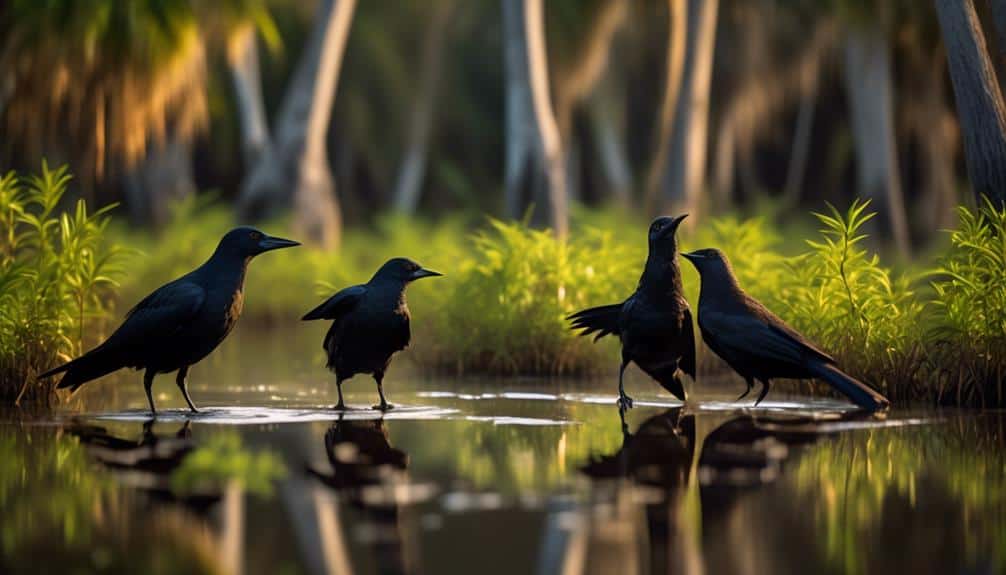
Black bird habitats in Florida exhibit a wide range of diversity, encompassing various ecosystems and landscapes. As I observe these habitats, I'm struck by the incredible migration patterns of black birds in Florida.
- Wetlands: The expansive wetlands of Florida provide a crucial habitat for black birds. These marshy areas, with their abundant water sources and dense vegetation, attract a variety of black bird species during their migrations. I've witnessed flocks of red-winged blackbirds and common grackles congregating in these wetlands, creating a mesmerizing symphony of calls and songs.
- Coastal Areas: The coastal areas of Florida offer another important habitat for black birds. The sandy beaches, mangrove forests, and salt marshes provide a haven for migratory black bird species such as the boat-tailed grackle and the tricolored blackbird. These birds can be seen foraging along the shoreline, searching for food in the form of insects, crustaceans, and small fish.
- Forests: The lush forests of Florida serve as an essential habitat for both resident and migratory black bird species. These wooded areas, with their tall trees and dense undergrowth, provide nesting sites and ample food sources for birds like the common crow and the brown-headed cowbird. However, these habitats are under threat from deforestation and urbanization, which can disrupt the delicate balance of the ecosystem and lead to a decline in black bird populations.
As I continue to explore the black bird habitats of Florida, I'm reminded of the importance of preserving these diverse ecosystems and protecting them from the threats they face. Only through conservation efforts can we ensure the continued existence of these magnificent birds and the habitats they rely on.
Behaviors and Characteristics of Florida Black Birds
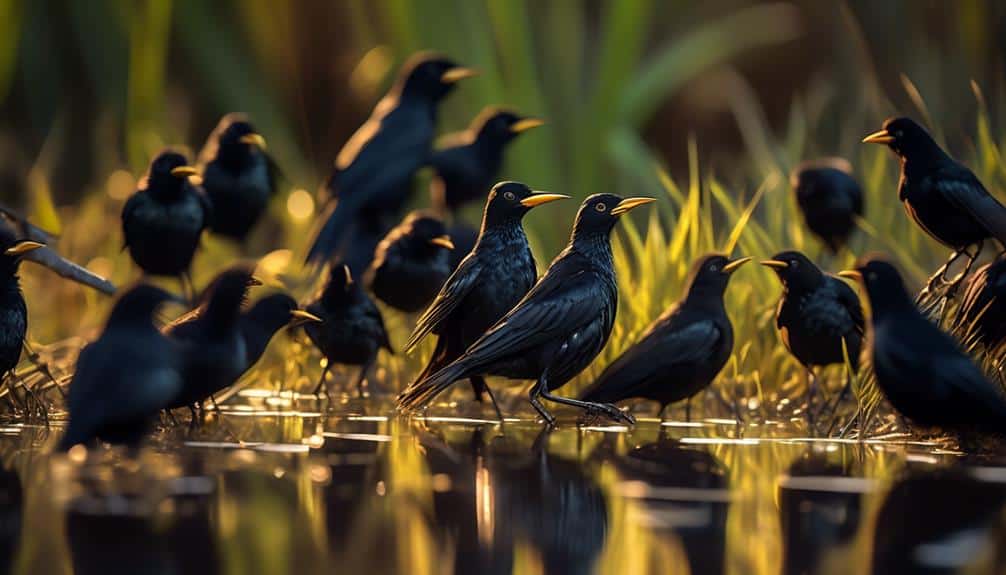
While exploring the diverse habitats of Florida's black birds, I've been fascinated by their unique behaviors and distinguishing characteristics. One of the most intriguing aspects of these birds is their migration patterns. Florida black birds, such as the red-winged blackbird and the common grackle, exhibit both short-distance and long-distance migrations.
Some species, like the red-winged blackbird, are known to migrate to southern Florida during the winter months, while others, like the common grackle, migrate all the way to Central and South America. These migrations are crucial for their survival, as they allow the birds to find suitable food sources and escape harsh weather conditions.
In addition to their migration patterns, the nesting habits of Florida black birds are also worth noting. Many species build their nests in dense vegetation, such as cattails or marsh grasses, near bodies of water. The nests are usually cup-shaped and made of grasses, leaves, and other plant materials. It isn't uncommon to find multiple nests in close proximity, as some species are colonial nesters.
These colonies provide protection against predators and allow the birds to share resources.
The Role of Black Birds in Florida's Ecosystem
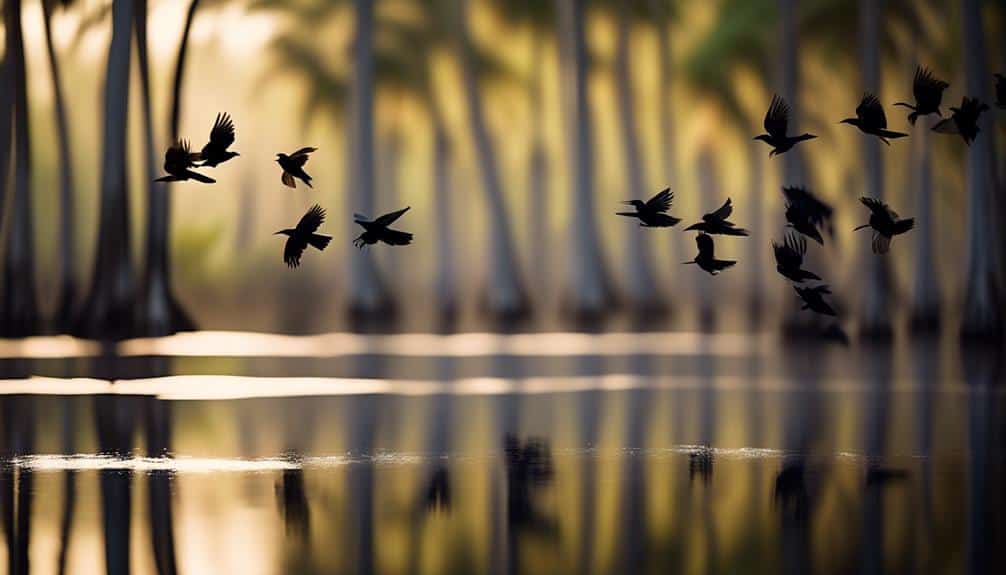
Florida's black birds play a crucial role in the state's ecosystem, contributing to the balance and functionality of their respective habitats. Here are three key aspects of their role:
- Black bird migration patterns in Florida: The black birds in Florida exhibit fascinating migration patterns, with some species traveling long distances to reach the state during the winter months. For example, the red-winged blackbird, commonly found in Florida, migrates from as far north as Canada to spend the winter in the state's wetlands. This migration not only helps in the dispersal of seeds and nutrients but also contributes to the biodiversity of the region.
- The impact of climate change on Florida's black bird population: Climate change poses a significant threat to Florida's black bird population. Rising temperatures, sea-level rise, and increased frequency of extreme weather events can disrupt their habitats, affecting their nesting sites, food availability, and overall survival. This disruption can lead to population decline and ecological imbalances within the ecosystem.
- Role as seed dispersers: Black birds, such as the common grackle and boat-tailed grackle, play an important role in seed dispersal. They consume fruits, berries, and seeds, and then disperse the undigested seeds through their droppings. This process helps in the regeneration and colonization of various plant species across the state, contributing to the overall health and diversity of Florida's ecosystems.
Understanding the role of black birds in Florida's ecosystem is vital for conservation efforts and ensuring the preservation of these valuable species in the face of ongoing environmental challenges.
Tips for Birdwatching and Attracting Black Birds in Florida
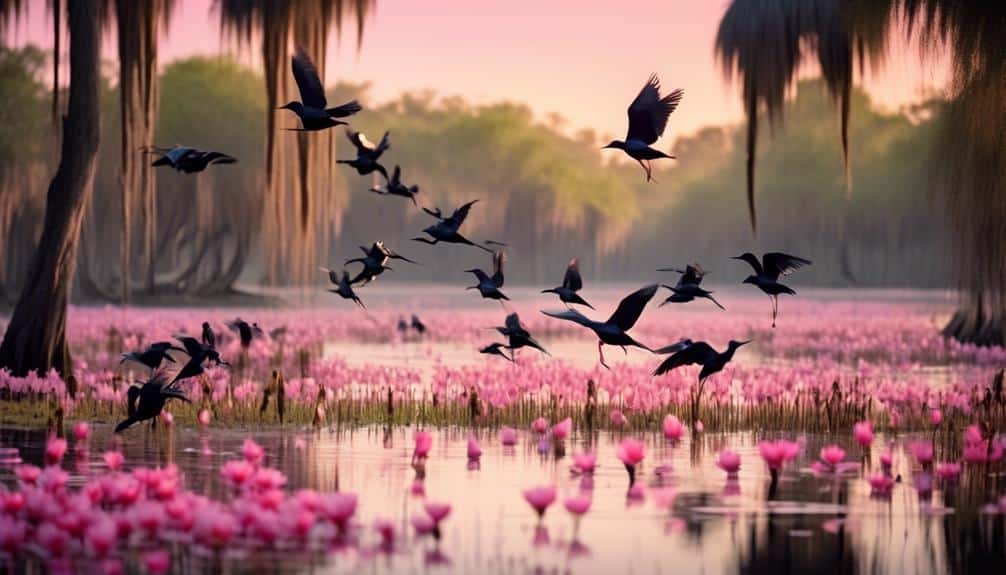
As I observe the fascinating migration patterns and crucial role of black birds in Florida's ecosystem, I can't help but wonder how I can enhance my birdwatching experience and attract these magnificent creatures to my own backyard.
To improve my birdwatching techniques, I've found that finding the right location is key. Black birds tend to frequent wetland areas, such as marshes and swamps, so finding a nearby nature reserve or wetland park would be ideal. These habitats offer a rich variety of food sources and nesting sites for black birds.
In addition to choosing the right location, using bird feeders can also be effective in attracting black birds. Opting for feeders specifically designed for larger birds, such as platform or hopper feeders, can accommodate the size and feeding habits of black birds. Fill these feeders with a mix of seeds, fruits, and suet, as black birds have diverse diets and are attracted to a variety of food sources.
To further enhance the birdwatching experience, creating a bird-friendly environment in my backyard is crucial. Planting native vegetation, such as elderberry, mulberry, and wax myrtle, can provide both food and shelter for black birds. Additionally, providing a water source, such as a birdbath or shallow dish, can attract black birds, as they require water for drinking and bathing.
Frequently Asked Questions
Are All Black Birds in Florida the Same Species?
All black birds in Florida are not necessarily the same species. Black bird behavior and nesting habits can vary among different species, making it important to identify specific characteristics and behaviors to determine the species.
How Do Black Birds in Florida Protect Their Nests From Predators?
Black birds protect their nests from predators by using various strategies. They build their nests in hidden locations, such as dense foliage or high up in trees. They also form large flocks, which helps deter potential threats.
Can Black Birds in Florida Mimic Human Speech Like Some Other Bird Species?
Black birds in Florida can mimic human speech, similar to other bird species. Their behavior is fascinating as they learn and imitate various sounds, making them seem like little parrots.
Do Black Birds in Florida Migrate to Other Areas During Certain Times of the Year?
Black birds in Florida exhibit interesting migratory patterns. Their population demographics suggest that they do migrate to other areas during certain times of the year. This behavior is worth studying further to understand their movement and ecological significance.
Are There Any Specific Plants or Feeders That Can Attract Black Birds to a Backyard in Florida?
Best practices for attracting black birds in Florida: plants and feeders. Tips for creating a black bird friendly backyard in Florida. I've found that providing a variety of native plants and using a mix of seed and suet feeders can help attract these beautiful birds.
Conclusion
In conclusion, observing Florida's black birds is like witnessing a synchronized ballet of ebony feathers. These remarkable creatures, with their distinct habitats and behaviors, play a vital role in the state's delicate ecosystem.
To catch a glimpse of these captivating avian dancers, one must learn the art of birdwatching and create an inviting environment for them.
So, grab your binoculars and prepare to be mesmerized by the majestic black birds of Florida.

